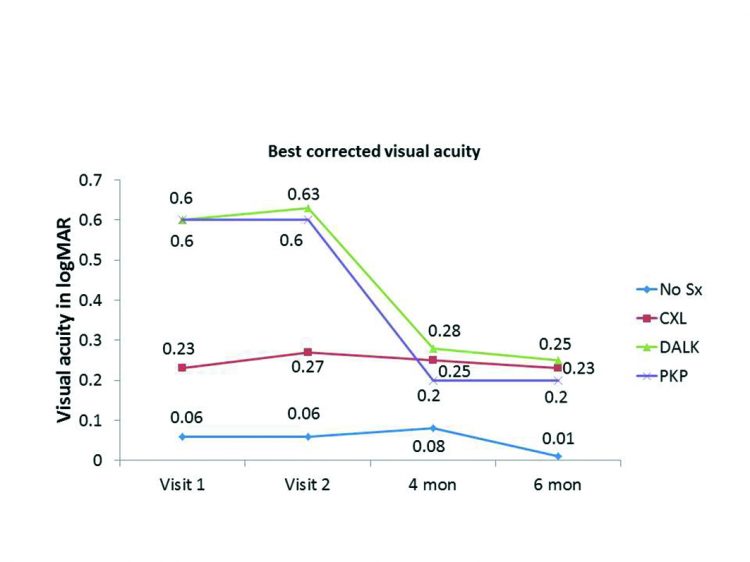Paediatric keratoconus

Cheryl Guttman Krader
Published: Wednesday, December 4, 2019
 Follow-up results of BCVA after surgical intervention. Image courtesy of Meenakshi Ravindran MD
A new prospective, observational study has provided a wealth of information on the incidence, clinical features, comorbidities and management outcomes of keratoconus in paediatric patients, said Meenakshi Ravindran MD.
Dr Ravindran, Aravind Eye Hospital, Tirunelveli, India, reported the data and compared them with previously published data at the World Society of Paediatric Ophthalmology & Strabismus Subspecialty Day in Paris, France.
The study identified patients aged 5 to 18 years seen between December 2016 and April 2017, with a diagnosis of keratoconus suspect, forme fruste keratoconus, early keratoconus or keratoconus having six months' follow-up. It found a 0.27% incidence of keratoconus among all paediatric patients (50/18,684 patients) and that the paediatric patients accounted for 21.93% of all patients with keratoconus (50/228).
“In their retrospective study, El-Khoury et al. reported these parameters to be 0.53% and 2.96%, respectively,” Dr Ravindran said.
Other endpoints were analysed for 70 eyes of 38 patients. The most common clinical features were scissoring (71%) and Fleischer’s ring (58%), while Vögt striae was seen in 38% of eyes. “Similar results have been noted by Sharma et al.,” Dr Ravindran said.
A history of vernal keratoconjunctivitis (VKC) was present in 50% of eyes, and there were no statistically significant differences in scanning slit topography (Orbscan II) parameters comparing eyes with and without VKC. Eye rubbing, bilateral disease, and mixed-type VKC were associated with more severe keratoconus.
“The lack of differences in topographic parameters between eyes with and without VKC is in contrast to a report by Taneja et al. The same authors also reported significant differences in topography only in the 3mm zone values comparing eyes with mixed and palpebral types of VKC,” Dr Ravindran said.
Within the Aravind Eye Hospital series, higher percentages of eyes that were recommended for surgical intervention at follow-up had adverse topographic parameters than those not so advised.
Surgery was recommended for 52 eyes. Corneal cross-linking was mostly advised and was performed in 42 eyes. Six eyes had deep anterior lamellar keratoplasty (DALK).
“CXL stabilised BCVA (see above), refraction and topographic parameters, and the visual outcomes were comparable to those of patients who had DALK. Our study indicates that DALK is an appropriate alternative to penetrating keratoplasty,” Dr Ravindran said.
She noted that the study has several limitations, including short recruitment and follow-up periods. In addition, the numbers of patients and their preoperative characteristics differed among the three surgical intervention groups.
“Therefore, the groups are not readily comparable. Furthermore, details of postoperative complications could not be assessed,” Dr Ravindran said.
Meenakshi Ravindran: drmeenakshi@aravind.org
Follow-up results of BCVA after surgical intervention. Image courtesy of Meenakshi Ravindran MD
A new prospective, observational study has provided a wealth of information on the incidence, clinical features, comorbidities and management outcomes of keratoconus in paediatric patients, said Meenakshi Ravindran MD.
Dr Ravindran, Aravind Eye Hospital, Tirunelveli, India, reported the data and compared them with previously published data at the World Society of Paediatric Ophthalmology & Strabismus Subspecialty Day in Paris, France.
The study identified patients aged 5 to 18 years seen between December 2016 and April 2017, with a diagnosis of keratoconus suspect, forme fruste keratoconus, early keratoconus or keratoconus having six months' follow-up. It found a 0.27% incidence of keratoconus among all paediatric patients (50/18,684 patients) and that the paediatric patients accounted for 21.93% of all patients with keratoconus (50/228).
“In their retrospective study, El-Khoury et al. reported these parameters to be 0.53% and 2.96%, respectively,” Dr Ravindran said.
Other endpoints were analysed for 70 eyes of 38 patients. The most common clinical features were scissoring (71%) and Fleischer’s ring (58%), while Vögt striae was seen in 38% of eyes. “Similar results have been noted by Sharma et al.,” Dr Ravindran said.
A history of vernal keratoconjunctivitis (VKC) was present in 50% of eyes, and there were no statistically significant differences in scanning slit topography (Orbscan II) parameters comparing eyes with and without VKC. Eye rubbing, bilateral disease, and mixed-type VKC were associated with more severe keratoconus.
“The lack of differences in topographic parameters between eyes with and without VKC is in contrast to a report by Taneja et al. The same authors also reported significant differences in topography only in the 3mm zone values comparing eyes with mixed and palpebral types of VKC,” Dr Ravindran said.
Within the Aravind Eye Hospital series, higher percentages of eyes that were recommended for surgical intervention at follow-up had adverse topographic parameters than those not so advised.
Surgery was recommended for 52 eyes. Corneal cross-linking was mostly advised and was performed in 42 eyes. Six eyes had deep anterior lamellar keratoplasty (DALK).
“CXL stabilised BCVA (see above), refraction and topographic parameters, and the visual outcomes were comparable to those of patients who had DALK. Our study indicates that DALK is an appropriate alternative to penetrating keratoplasty,” Dr Ravindran said.
She noted that the study has several limitations, including short recruitment and follow-up periods. In addition, the numbers of patients and their preoperative characteristics differed among the three surgical intervention groups.
“Therefore, the groups are not readily comparable. Furthermore, details of postoperative complications could not be assessed,” Dr Ravindran said.
Meenakshi Ravindran: drmeenakshi@aravind.org